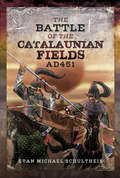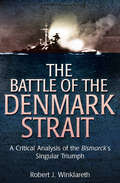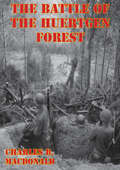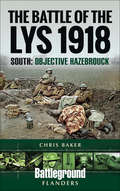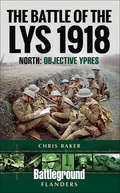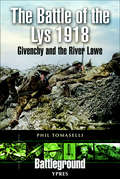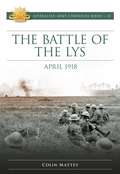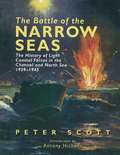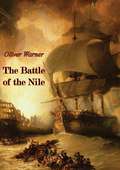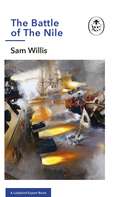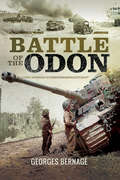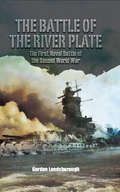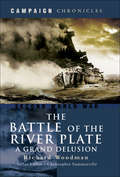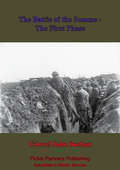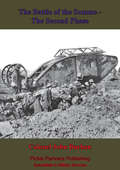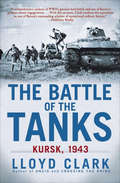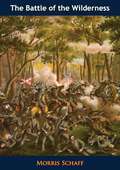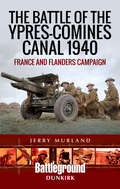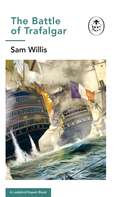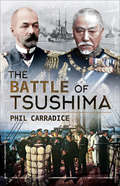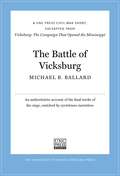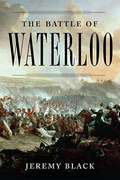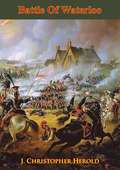- Table View
- List View
The Battle of the Catalaunian Fields AD 451: Flavius Aetius, Attila the Hun and the Transformation of Gaul
by Evan Michael SchultheisA reassessment of the famous fifth-century clash between Hun and Roman forces: &“An excellent job of research with original documents.&” —The Past in Review This book reconsiders the evidence for Attila the Hun&’s most famous battle, the climax of his invasion of the Western Roman Empire that had reached as far as Orleans in France. Traditionally considered one of the pivotal battles in European history, saving the West from conquest by the Huns, the Catalaunian Fields is here revealed to be significant but less immediately decisive than claimed. This new study exposes oversimplified views of Attila&’s army, which was a sophisticated and complex all-arms force, drawn from the Huns and their many allies and subjects. The &‘Roman&’ forces, largely consisting of Visigoth and Alan allies, are also analyzed in detail. The author, a reenactor of the period, describes the motives and tactics of both sides. Drawing on the latest historiography and research of the primary sources, and utilizing Roman military manuals, Evan Schultheis offers a completely new tactical analysis of the battle and a drastic reconsideration of Hun warfare, the Roman use of federates, and the ethnography of the Germanic peoples who fought for either side. The result is a fresh and thorough case study of battle in the fifth century. Includes maps and illustrations
The Battle of the Denmark Strait: A Critical Analysis of the Bismarck's Singular Triumph
by Robert WinklarethThis detailed analysis of the WWII naval battle by the acclaimed historian and mechanical engineer reveals new insight into the Bismarck&’s victory. In the spring of 1942, Nazi Germany unleashed its behemoth battleship Bismarck against the British in the Battle of the Denmark Strait. Bismarck destroyed the pride of the Royal Navy, HMS Hood, and severely damaged its newest battleship, HMS Prince of Whales. The decisive victory resonated both in Whitehall and Berlin—and yet there continues to be controversy as to how the conflict was actually fought. The Battle of the Denmark Strait offers a detailed technical analysis of combat circumstances, while new discoveries, revealed for the first time in this book, shed light on the battle. With a close examination of naval gunnery, from the various gun systems to the flight time of shells to their target, historian and mechanical engineer Robert Winklareth has painstakingly reconstructed the battle. He also explores events leading up to the titanic clash, as well as its aftermath.
The Battle of the Huertgen Forest
by Charles B. MacdonaldAn electrifying account of carnage and bravery...<P> In September 1944, three months after the invasion of Normandy, the Allied armies prepared to push the German forces back into their homeland. Just south of the city of Aachen, elements of the U.S. First Army began an advance through the imposing Huertgen Forest. Instead of retreating, as the Allied command anticipated, the German troops prepared an elaborate defense of Huertgen, resulting in a struggle where tanks, infantry, and artillery dueled at close range. The battle for the forest ended abruptly in December, when a sudden German offensive through the Ardennes to the south forced the Allied armies to fall back, regroup, and start their attack again, this time culminating in the collapse of the Nazi regime in May 1945.
The Battle Of The Huertgen Forest [Illustrated Edition]
by Charles Brown MacdonaldIncludes the Siegfried Line Campaign Map Pack - 19 maps and 81 photos“"A testament of the courage and endurance of our fighting men."-New York Times“In September 1944, three months after the invasion of Normandy, the Allied armies prepared to push the German forces back into their homeland. Just south of the city of Aachen, elements of the U.S. First Army began an advance through the imposing Huertgen Forest. Instead of retreating, as the Allied command anticipated, the German troops prepared an elaborate defense of Huertgen, resulting in a struggle where tanks, infantry, and artillery dueled at close range. The battle for the forest ended abruptly in December, when a sudden German offensive through the Ardennes to the south forced the Allied armies to fall back, regroup, and start their attack again, this time culminating in the collapse of the Nazi regime in May 1945.“In The Battle of the Huertgen Forest, Charles B. MacDonald assesses this major American operation, discussing the opposing forces on the eve of the battle and offering a clearly written and well-documented history of the battle and the bitter consequences of the American move into the forest. Drawing on his own combat experience, MacDonald portrays both the American and the German troops with empathy and convincingly demonstrates the flaws in the American strategy. The book provides an insight into command decisions at both local and staff levels and the lessons that can be drawn from one of the bloodiest battles of World War II.“Charles B. MacDonald was deputy chief historian of the Army Center of Military History. He commanded a rifle platoon in World War II, earning the Silver Star, a Purple Heart, and five battle stars. He recorded his wartime experiences in Company Commander, regarded as one of the finest World War II combat narratives.”-Print Ed.
The Battle of the Lys, 1918: Objective Hazebrouck (Battleground Books: Wwi Ser.)
by Chris BakerThe German offensive in Flanders in April 1918 came close to catastrophe for the British Armies, but ultimately ended in strategic defeat for the Kaisers men. Following closely on the heels of the devastating Operation Michael attack in March on the Somme and around Arras, named as Operation Georgette, the offensive was aimed at strangling the vital railways and roads that supplied the British at Ypres.Having assembled an overwhelming numerical advantage, the Germans attacked in thick fog on 9 April 1918. They faced tired British formations that had just been relieved from the earlier battle and which were receiving replacements, mainly in the form of 18 year-old conscripts. By the days end, the Germans had succeeded in gaining a crossing of the River Lys and were well on their way to the vital railway junctions at Hazebrouck. Several British divisions were deployed to stop the advance, only to be effectively destroyed in the attempt over the next few days. Gradually, fresher British, Australian and French reserves arrived and held their ground. With disappointing results, mounting casualties and a diminishing return for their efforts, the Germans abandoned the offensive and turned their attention further south.What the British call The Battle of the Lys 1918 is a fascinating yet curiously neglected period of military history. Chris Baker examines this major battle from the strategic down to the platoon level, highlighting the key events, characters and acts of enormous bravery on both sides, both in a historical narrative and in a series of tours of the area.This volume, one of two on the battle, concentrates on the southern half of the battlefield.
The Battle of the Lys, 1918: Objective Ypres
by Chris BakerThe second of two Battelground Europe titles covering this highly significant battle of spring 1918.The German offensive in Flanders in April 1918 came close to catastrophe for the British Armies, but ultimately ended in strategic defeat for the Kaisers men. Following close on the heels of the devastating Operation Michael attack in March, which had been aimed against the British front on the Somme and Arras, this offensive, Operation Georgette, was aimed at strangling the vital railways and roads that supplied the British at Ypres and threatening the vital logistics links with the Channel Ports.Having assembled an overwhelming numerical advantage, the Germans attacked in thick fog on 9 April 1918. By days end, the Germans had succeeded in gaining a crossing of the River Lys and were well on their way to the railway junctions at Hazebrouck. Next day, they extended the attacked front northwards and advanced to the very gates of Ypres, forcing a British retirement from the bloodily won advances during the Third Battle of Ypres. Messines Ridge, captured so spectacularly by the British in June 1917, was soon in German hands and fighting inched towards Mont Kemmel, which dominated the Ypres front. Once this fell, the way was open for the capture of the main supply roads into Ypres.To find sufficient reserves to counter the German attack, the British took the heart-breaking decision to abandon the ground won so dearly in the Passchendaele offensive in the summer and autumn of 1917. Gradually, fresher British and French reserves arrived and held their ground. With disappointing results, mounting casualties and a diminishing return for their efforts, the Germans paused to regroup. Late in the month they unleashed a rapid, unstoppable attack that captured Kemmel from the French forces that had been rushed north to reinforce the threatened line and which had been holding the summit: one of the finest military feats of the Great War.Behind the scenes, however, the Germans were already calling off a continuation of the offensive and so, by a seeming miracle, the bastion that was Ypres remained in British hands.What the British call The Battle of the Lys 1918 is a fascinating yet curiously neglected period of military history. Chris Baker examines this major battle from the strategic down to the platoon level, highlighting the key events, characters and acts of enormous bravery on both sides, both in historical narrative and in a series of tours of the area.This volume concentrates on the northern half of the battlefield; nearly all of the actions described in this volume took place in Belgium.
The Battle of the Lys, 1918: Givenchy and the River Law (Battleground I Ser.)
by Phil TomaselliThe battles fought at Estaires and Givenchy, just south of Ypres, in April 1918 were critical episodes in the larger Battle of Lys which determined the outcome of the ultimate German offensive on the Western Front. The massive assault of Ludendorffs armies crashed against defenses manned by the British and Portuguese. A series of intense attacks and counterattacks followed, and the Germans were on the verge of gaining the decisive breakthrough that both sides on the Western Front had struggled for since the onset of trench warfare in late 1914. A German success might well have forced the British to retreat from Ypres. Phil Tomasellis vivid account reconstructs events in the typical Battleground style. He describes the course of the fighting in close detail, using eyewitness accounts, official records, photographs and maps, and he provides walking and driving tours of the battlefield and of the monuments and cemeteries associated with it.
The Battle of the Lys April 1918 (Australian Army Campaigns #25)
by Colin MatteyIn the wave of devastating German offensives launched in the spring of 1918, it is Operation Michael that has captured most attention, characterised by astonishing advances and their potentially shattering impact on the British Expeditionary Force’s (BEF) Third and Fifth armies. While this offensive eventually petered out, albeit tantalisingly close to the BEF’s crucial logistic hub of Amiens, German General Ludendorff redirected the German effort north to Flanders to launch Operation Georgette. In Flanders, the BEF front line lay alarmingly close to the vital channel ports, and the main German thrust posed a direct threat to the town of Hazebrouck, the BEF’s second key logistic hub. After four years of grinding and horrific war, all that stood between the Germans and victory was the 1st Australian Division, hastily recalled to defend the town. This volume describes the battle to save Hazebrouck — part of what was to become the Battle of the Lys — and focuses on the role of the 1st Australian Division in halting the surging German thrust towards the town. While often neglected by history, this action was critical to the survival of the BEF and the Allied war effort in 1918 and deserves far greater recognition. The Battle of the Lys also brings the performance of the BEF divisions during Operation Georgette into sharper focus while providing a unique opportunity to reassess BEF and German performances at what was a decisive point in the First World War.
The Battle of the Narrow Seas: The History of Light Coastal Forces in the Channel and North Sea, 1939–1945
by Peter ScottThis is the story of the struggle for the control of the narrow seas of the Channel and the southern North Sea during the Second World War, told by Peter Scott who, as a MTB commander, saw action against the enemy throughout the course of the War.The book is much more than a memoir and tells the whole story of the wide-ranging conflict against the Germans, fought in the congested waters of the Channel. Actions against convoys and E-boats, often under the shadows of French cliffs, an impossible sortie against Scharnhorst and Gneisenau as they ran the gauntlet through the Straits in February 1942, the attack on St Nazaire, and the defensive and offensive roles taken on by MTBs during the D-Day landings are just some of the events covered in the book.The bravery of the crews of these small ships became legendary and the casualties that were suffered during brief and fierce encounters were horrific. As the War dragged on Motor Torpedo Boats became household words, and their activities, often described, perhaps a little luridly in the press, helped to raise the morale of the nation in much the same way that the fighter aircraft had done in the Battle of Britain in September 1940. A much-needed new edition.
The Battle of the Nile
by Oliver WarnerFirst published in 1960, this is a gripping account of the decisive sea battle between the forces of Napoleon and the British under Nelson in 1798.The Battle of the Nile (also known as the Battle of Aboukir Bay) was a major naval battle fought between the British Royal Navy and the Navy of the French Republic at Aboukir Bay on the Mediterranean coast off the Nile Delta of Egypt from 1-3 August 1798. The battle was the climax of a naval campaign that had ranged across the Mediterranean during the previous three months, as a large French convoy sailed from Toulon to Alexandria carrying an expeditionary force under General Napoleon Bonaparte. The British fleet was led in the battle by Rear-Admiral Sir Horatio Nelson.
The Battle of The Nile: A Ladybird Expert Book (The Ladybird Expert Series #35)
by Sam WillisPart of the ALL-NEW LADYBIRD EXPERT SERIES- Why was the Battle of the Nile so decisive in the French Revolutionary Wars?- Why did the French believe they were unassailable?- And why did Nelson and the British win?TRACK the revolutionary roots and dramatic turning points of the British Royal Navy's glorious victory over the French naval expedition to Egypt. From Napoleon's rise to prominence to Nelson's celebrated tactical leadership, discover how this significant battle changed the face of the French Revolutionary Wars.THE BATTLE THAT CHANGED THE BALANCE OF POWER IN EUROPEWritten by historian, archaeologist, and broadcaster Sam Willis, Nelson: Battle of the Nile is a thrilling and accessible account of the naval battle that established Nelson's fame.
Battle of the Odon
by Georges BernageThe Battle of the Odon evokes the clash between the British Army and the II SS-Panzer Korps, as they attacked across the Odon Valley during Operation "Epsom" in June 1944.Using contemporary photographs and documents, this book provides day-by-day details of the operation that was just one part of what is commonly referred to as the 'Battle of Normandy'.
The Battle of the River Plate: The First Naval Battle of the Second World War
by Gordon LandsboroughAt dawn on 13 December 1939, smoke was seen on the horizon; HMS Exeter was told to close in and investigate. Two minutes later a dramatic signal was sent from the British cruiser I think it is a pocket battleship.It was. The Deutschland-class heavy cruiser Admiral Graf Spee, marauder of the South Atlantic shipping, had sailed into a trap. Three smaller British cruisers closed in on a German warship which, so Hitler had boasted, could out-sail any ship powerful enough to damage her, and out-gun any ship able to keep up with her an invincible ship.So began the Battle of the River Plate, story which has its duplicates in British naval history, but which nevertheless brought pride and inspiration into the hearts of a nation unwillingly at war once again.A terrible battle was fought that day off the coast of South America, a naval encounter in the finest Nelson tradition and true to that tradition, victory went to the men with the finest armament of all, courage.This edition will be presented with an Appendix containing the official despatch detailing the Battle of the River Plate.
The Battle of the River Plate: A Grand Delusion (Campaign Chronicles)
by Richard WoodmanA study and reassessment of the major World War II battle in the South Atlantic between the British and German navies. The Battle of the River Plate was the first major naval confrontation of the Second World War, and it is one of the most famous. The dramatic sea fight between the German pocket battleship Admiral Graf Spee and the British cruisers Exeter, Ajax, and Achilles off the coast of South America caught the imagination in December 1939. Over the last sixty years the episode has come to be seen as one of the classics of naval warfare. Yet the accepted interpretation of events has perhaps been taken for granted and is ripe for reassessment, and that is one of the aims of Richard Woodman&’s enthralling new study.Praise for The Battle of the River Plate: A Grand Delusion &“This author has made it all so very riveting, it really is a book which is hard to put down until finished.&” —Royal Geographical Society &“Graphic, thought provoking—highly recommended.&” —Britain at War
The Battle Of The Somme - The First Phase. [Illustrated Edition]
by Colonel John BuchanMore than any other battle of the First World War, the battle of the Somme remains as the abiding memory of the appalling conditions, suffering and death of British manhood in the public consciousness. As the guns stopped their bombardment on the 1st of July, the waves of Allied troops walked toward the often still intact German lines. More than a million men in total would be killed, wounded or captured on both sides before the fighting subsided in November.Colonel Buchan wrote his volume study of the battle from an enviable position as a high ranking intelligence officer, having access to much of the detail from the allied side of the offensive. One of the finest British authors of the age, he also wrote copious numbers of books on the First World War, of particular note the 24 volume 'Nelson's" history.Author -- Colonel Buchan, John, (Later Lord Tweedsmuir) 1875-1940.Text taken, whole and complete, from the edition published in London, T. Nelson and sons, ltd. 1916.Original Page Count - 108 pages.Illustrations -- numerous illustrations and plates
The Battle Of The Somme –The Second Phase. [Illustrated Edition]
by Colonel John BuchanMore than any other battle of the First World War, the battle of the Somme remains as the abiding memory of the appalling conditions, suffering and death of British manhood in the public consciousness. As the guns stopped their bombardment on the 1st of July, the waves of Allied troops walked toward the often still intact German lines. More than a million men in total would be killed, wounded or captured on both sides before the fighting subsided in November.Colonel Buchan wrote his volume study of the battle from an enviable position as a high ranking intelligence officer, having access to much of the detail from the allied side of the offensive. One of the finest British authors of the age, he also wrote copious numbers of books on the First World War, of particular note the 24 volume 'Nelson's" history.Author -- Colonel Buchan, John, (Later Lord Tweedsmuir) 1875-1940.Text taken, whole and complete, from the edition published in London, T. Nelson and sons, ltd. 1916.Original Page Count - 108 pages.Illustrations -- numerous illustrations and plates.
The Battle of the Tanks: Kursk, 1943
by Lloyd ClarkOn July 5, 1943, the greatest land battle in history began when Nazi and Red Army forces clashed near the town of Kursk, on the western border of the Soviet Union. Code named "Operation Citadel,” the German offensive would cut through the bulge in the eastern front that had been created following Germany’s retreat at the battle of Stalingrad. But the Soviets, well-informed about Germany’s plans through their network of spies, had months to prepare. Two million men supported by 6,000 tanks, 35,000 guns, and 5,000 aircraft convened in Kursk for an epic confrontation that was one of the most important military engagements in history, the epitome of "total war.” It was also one of the most bloody, and despite suffering seven times more casualties, the Soviets won a decisive victory that became a turning point in the war. With unprecedented access to the journals and testimonials of the officers, soldiers, political leaders, and citizens who lived through it, The Battle of the Tanks is the definitive account of an epic showdown that changed the course of history.
The Battle of the Wilderness
by Morris SchaffThe Battle of the Wilderness was fought on May 5–7, 1864 as the first battle of Lt.-Gen. U. S. Grant's Virginia Overland Campaign against Gen. Robert E. Lee and the Confederate Army of Northern Virginia. The fighting occurred in a wooded area near Locust Grove, Virginia, about 20 miles west of Fredericksburg. Although tactically inconclusive, both armies suffered heavy casualties, nearly 29,000 in total, a harbinger of a war of attrition by Grant against Lee's army and, eventually, the Confederate capital, Richmond, Virginia.>Grant attempted to move quickly through the dense underbrush of the Wilderness of Spotsylvania, but Lee launched two of his corps on parallel roads to intercept him. On the morning of May 5, the Union V Corps under Maj.-Gen. G. K. Warren attacked the Confederate Second Corps, commanded by Lt.-Gen. R. S. Ewell, on the Orange Turnpike. That afternoon the Third Corps, commanded by Lt.-Gen. A. P. Hill, encountered Brig.-Gen. G. W. Getty's division (VI Corps) and Major-Gen. W. S. Hancock's II Corps on the Orange Plank Road. Fighting, which ended for the evening because of darkness, was fierce but inconclusive as both sides attempted to maneuver in the dense woods.At dawn on May 6, Hancock attacked along the Plank Road, driving Hill's Corps back in confusion, but the First Corps of Lt.-Gen.l James Longstreet arrived in time to prevent the collapse of the Confederate right flank. Longstreet followed up with a surprise flanking attack that drove Hancock's men back, but the momentum was lost when Longstreet was wounded by his own men. An evening attack by Brig.-Gen. J. B. Gordon against the Union right flank caused consternation at the Union headquarters, but the lines stabilized and fighting ceased. On May 7, Grant disengaged and moved to the southeast, intending to leave the Wilderness to interpose his army between Lee and Richmond, leading to the Battle of Todd's Tavern and Battle of Spotsylvania Court House.
The Battle of the Ypres-Comines Canal 1940: France and Flanders Campaign (Battleground Dunkirk)
by Jerry MurlandThis WWII history and battlefield guide explores the significant yet lesser-known WWII combat along the Ypres-Comines Canal during the Battle of France.Known in some accounts as the Battle of Wijtschaete, the confrontation along the Ypres-Comines Canal in 1940 is too often overlooked despite its significance. The sacrifice of the battalions on the canal was vital to the all-important retreat to Dunkirk. The four-day conflict likely saved the British Expeditionary Force from almost complete destruction.Although there was fighting north of Ypres along the Canal Van Ieper Naar De Ijzer, the actual Battle of the Ypres-Comines Canal took place to the south. Three British brigades were pitted against three German divisions along the disused canal which runs from Comines in the south to Ypres in the north. Military historian Jerry Murland covers the order of battle of the British and German units engaged in the fighting.With more than 150 historic and modern photographs, ten maps, visits to eight CWGC Cemeteries, plus three car tours and two walking itineraries, this volume is an essential companion for exploring the area. Visitors will no doubt wish to combine a visit to the First World War sites around Ypres with the fighting along the canal in 1940, recognizing many places that were fought over in both wars.
The Battle of the Ypres-Comines Canal 1940: France and Flanders Campaign (Battleground Dunkirk)
by Jerry MurlandThis WWII history and battlefield guide explores the significant yet lesser-known WWII combat along the Ypres-Comines Canal during the Battle of France.Known in some accounts as the Battle of Wijtschaete, the confrontation along the Ypres-Comines Canal in 1940 is too often overlooked despite its significance. The sacrifice of the battalions on the canal was vital to the all-important retreat to Dunkirk. The four-day conflict likely saved the British Expeditionary Force from almost complete destruction.Although there was fighting north of Ypres along the Canal Van Ieper Naar De Ijzer, the actual Battle of the Ypres-Comines Canal took place to the south. Three British brigades were pitted against three German divisions along the disused canal which runs from Comines in the south to Ypres in the north. Military historian Jerry Murland covers the order of battle of the British and German units engaged in the fighting.With more than 150 historic and modern photographs, ten maps, visits to eight CWGC Cemeteries, plus three car tours and two walking itineraries, this volume is an essential companion for exploring the area. Visitors will no doubt wish to combine a visit to the First World War sites around Ypres with the fighting along the canal in 1940, recognizing many places that were fought over in both wars.
Battle of Trafalgar: A Ladybird Expert Book (The Ladybird Expert Series #28)
by Sam WillisPart of the ALL-NEW LADYBIRD EXPERT SERIES'Packs plenty of heft into its slender page count' HISTORY REVEALED- Why was the Battle of Trafalgar such an important British victory in the Napoleonic Wars? - How did the British fleet show their strength against the French and Spanish? - How did Nelson excel in his final battle?FOLLOW the daring strategy and brilliant leadership of Horatio Nelson in Britain's stunning triumph against Napoleon's forces. From the might of Britain's war machine to the death of the world's most impressive naval commander, discover why Trafalgar remains the most famous naval battle in history.BRITAIN'S GLORIOUS VICTORY, AND NELSON'S FINAL BATTLEWritten by historian, archaeologist, and broadcaster Sam Willis, The Battle of Trafalgar is a gripping and accessible introduction to the battle that established Britain as a formidable seapower for many years to come.
The Battle of Tsushima
by Phil CarradiceThe author of The First World War in the Air details the gripping 1905 naval battle during the Russo-Japanese War.In 1905 Japan and Russia were at war. With the Russian Far East Fleet destroyed, the Czar sent his Baltic Fleet halfway around the world to exact revenge. This mammoth journey took many months and was an amazing feat of seamanship. But, at the end of this adventure, the Russians were totally overwhelmed, and the majority of the fleet was underwater. There was no alternative for the Czar but to sue for an ignominious peace.The story of the journey and the final battle remain fascinating, the people involved behaving like characters from a novel. Russian Admiral Rozhestvensky was a gunnery expert but had never held active command in a major sea battle. Japanese Admiral Togo had trained in Britain, enlisting as a cadet on the Training Ship Worcester, even though he was far too old and was forced to lie about his age. Inept generalship on the part of the Russians, combined with brilliant seamanship from Togo, saw the complete destruction of the Russian fleet.The naval battle of Tsushima is one of the forgotten actions of the twentieth century, but it has a significance that is immense in world history.“An utterly compelling story, well told by Carradice. We really sympathize with the Russian sailors, trapped on their ironclad warships for months as they battled against the elements, a largely hostile world, and even each other. The result is an excellent book that reminds us of the human cost of these massive naval battles.” —History of War
The Battle of Vicksburg
by Michael B. BallardThe Vicksburg campaign was among the longest of the Civil War, lasting from 26 May 1862 to 4 July 1863. This Civil War Short provides a compelling narrative of the final six weeks of the campaign, excerpted from Michael Ballard's Vicksburg: The Campaign That Opened the Mississippi, which blends strategy and tactics with the human element, reminding us that while Gettysburg has become the focal point of the history and memory of the Civil War, the outcome at Vicksburg was met with as much celebration and relief in the North as the Gettysburg victory, and it should be viewed as equally important today.UNC Press Civil War Shorts excerpt rousing narratives from distinguished books published by the University of North Carolina Press on the military, political, social, and cultural history of the Civil War era. Produced exclusively in ebook format, they focus on pivotal moments and figures and are intended to provide a concise introduction, stir the imagination, and encourage further exploration of the topic. For in-depth analysis, contextualization, and perspective, we invite readers to consider the original publications from which these works are drawn.
The Battle of Waterloo
by Jeremy BlackThe name Waterloo has become synonymous with final, crushing defeat. Now thislegendary battle is re-created in a groundbreaking book by an eminent Britishmilitary historian making his major American debut.
Battle Of Waterloo [Illustrated Edition]
by J. Christopher Herold Jean HanoteauIllustrated with documents, paintings, and relics of the period. Renowned Napoleonic historian, J. Christopher Herold recounts the fascinating details of the great battle of Waterloo which ended the career of the greatest conqueror of modern times--Napoleon Bonaparte, Emperor of the French.
